The barking treefrog is a true favorite! I have known a number of people who enjoy herping this amusing, amazing, and colorful frog. This large t
The barking treefrog is a true favorite! I have known a number of people who enjoy herping this amusing, amazing, and colorful frog. This large treefrog is a delight to herp for, and often allows for very close approach in the field. In this article we'll take a look at some of the "froggy facts" about this species.
Read More
For a frog with such a large range across the southeast United States, many miles may pass you by before hearing a chorus of them. They are a bit habitat specific, and areas that literally overflow with other species may be lacking these entirely. In some areas of swampland miles across only a dozen or so barkers (Hyla gratiosa) can be heard – usually calling out from just one or two small areas of the otherwise vast swampland. In areas where they breed along with the green treefrog (Hyla cinerea) hybridization sometimes occurs between the two species. We'll take a look at that shortly, but if there was a "perfect" habitat for this species it would not be a vast swamp, but rather a small clear-water pond totally lacking fish. The large tea-colored swamplands that dot the Southeast are mostly avoided by them, and barking treefrogs are almost entirely lacking in such areas with the exception of an occasional "satellite" specimen that calls from among the treetops or comes to a porch light at night in such areas, and lives its life entirely without breeding. This may make them seem fairly uncommon, and in many areas they are, but in other areas they ring out their calls in such great numbers that people living near them close their windows at night to drown out the roaring of their croaks!
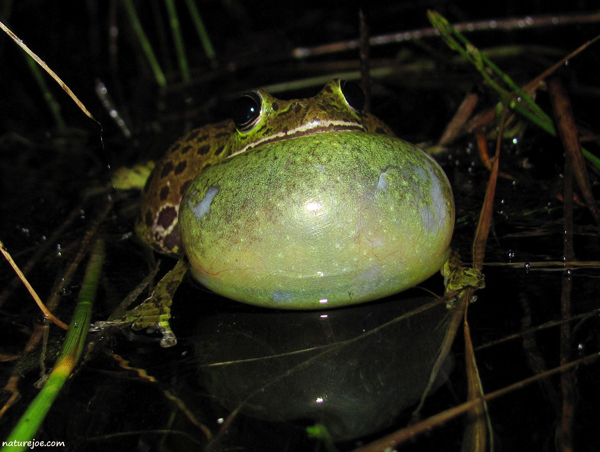
joe myers
Barking treefrogs croak loudly and can be heard from great distances.
Barking treefrogs seem to prefer man made ponds and structures over the more "wild" areas, and the introduction of people into their habitat may have actually helped them. Open ponds in old overgrown construction areas, roadside ditches, seasonally-wet low areas in old fields, retention ponds for flood control, quarries, and old swimming pools will often attract many, providing there are no fish. The guppy-like mosquito fish released into the wetlands for insect control will consume most of the tadpoles at hatching time, and almost none survive to froghood when these are present. Larger fish will eat those that remain. In places where barking treefrogs breed abundantly, water snakes take a few every night, but with such vast numbers of frogs, this hardly puts a dent in the population. As stated earlier, ponds rather than swamps will often harbor many hundreds, and in the deeper, vegetation-covered open marshy wetlands that contain fish (including some large species such as bass), barkers will be present but in lower numbers, providing the water has good visibility. Be prepared to go into deep water to approach them in such situations, clinging to a lilypad or floating upon clumps of algae, while in their preferred ponds they can be easily approached without ever getting your feet wet.
When not breeding barking treefrogs occupy a wide variety of habitats, and can be found beneath trash on the ground, high up in the treetops, and as a gardener I have dug them out of the ground a number of times, especially during extremely hot or cool weather, and have found them in the greenhouse, where they will often spend the winter. Otherwise (here in North Florida) I start seeing them around late-March, and begin to hear them in April.
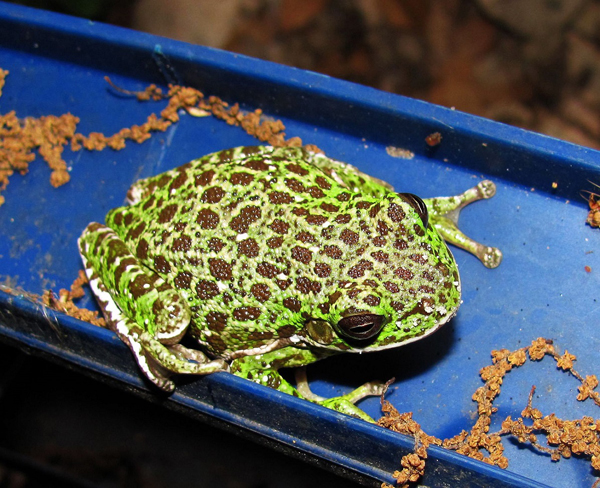
joe myers
This is a 300-gallon plastic container which I have set up naturally, and each year it hosts a number of Hylas (treefrogs) that were started here years ago as tadpoles.
In the Carolinas they breed starting in April, and will breed in all areas throughout much of the summer when the warm rains come. One thing I find interesting concerning these is they will migrate to their breeding pools on warm dry nights, and even when there's no rain for weeks these will migrate to breed along with the common toad (Bufo terrestris), and will be joined there by the leopard frogs (Rana spp.)and others that are already there.
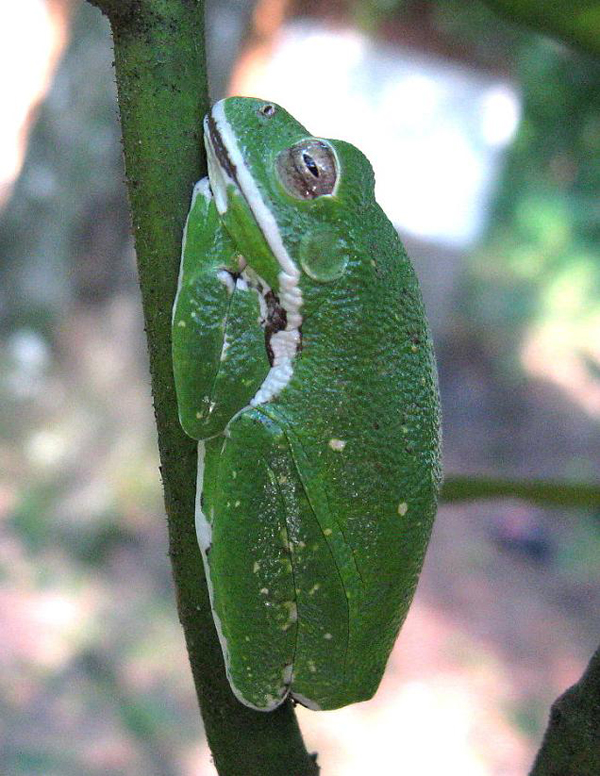
joe myers
This barking treefrog is fast asleep, which is a common position for most treefrogs during the daytime, and this one is the "green" phase of the species.
Unlike the other treefrogs that will utter their breeding calls from a number of different places, including trees and bushes a good distance from the water, the barkers do not. Barkers puff themselves up looking much like "four-legged balloons" and will emit their explosive croak while floating high on the surface of the water very much like the Spadefoots (Scaphiopus holbrookii), often while holding onto a floating reed or blade of grass. The males may call loudly for several nights before the females appear.
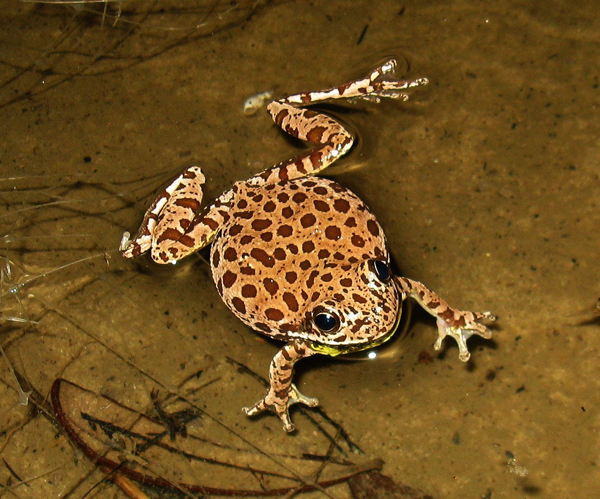
joe myers
This barking treefrog shows no green whatsoever! It has only one thing that remains constant – the spots.
Once the females arrive they remain ashore for awhile – almost as if they're "cruising" the males for the one with the lowest voice. Once a male is selected she will approach him with great gusto and lock onto him in a breeding embrace, and after a short scuffle he will take hold of her in the proper amplexus.
She usually leaves the water with him on her back rather quickly, and if they remain in the water long after first contact, other nearby males will be drawn to the scene, and a "triple decker croaker stacker" may result! In this harmless antic a third male will rush in and cling to the back of the original male for a temporary threesome, and after awhile the third male releases his grip and returns to the night. During a large chorus perhaps a couple hundred can be seen floating around croaking loudly, and checking out everything that moves in hopes of that moving object being an approaching female.
Photo suggestion (05 Triple) This sometimes happens whenever they gather in great numbers.
Anywhere from a few minutes to over an hour later the connected pair returns to the water, usually in an area not near any other calling males, and she will select places to lay her eggs. At this time she'll cling to a floating sprig of vegetation and attach some eggs to this before moving onto another floating reed or other vegetation. Once she is finished the male leaves her back and she quickly leaves the area. The male will return to his boisterous loud croaking as if to say "Next!" These produce a fairly large tadpole for the size of the frog, and have a rather long larval cycle as well, and eggs laid in late-April will emerge as bright green froglets in late-July or August. The juveniles can be highly abundant at such times, and on warm or wet nights these can be seen clambering through the low vegetation near the pond and in the trees themselves, and will return in about two years to breed.
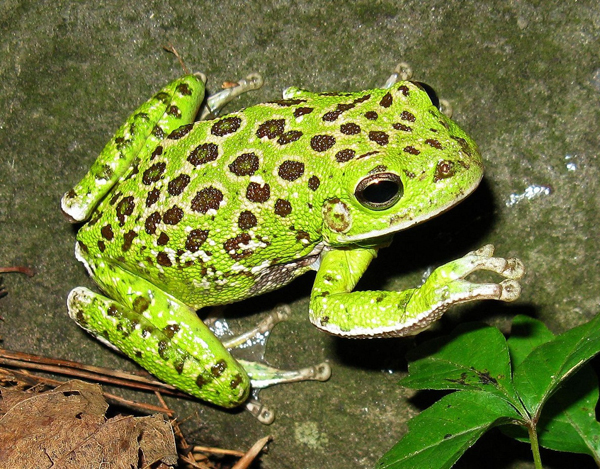
joe myers
No no we mustn't touch. That's poison ivy!
In areas where the green treefrog breeds along with them an "accident" sometimes happens, and the result is a hybrid that has a strong resemblance to both species – including the breeding call. Often with the body shape of the Green treefrog, an overtone of the spotted pattern can be seen, and concerning the voice the Barker has a strong and clear "Dooont!" while the Green has a nasal higher-pitch explosive "Ain't!", and the hybrid utters a note clearly different from the others, which makes them easy to locate in the vast crowd of croakage. The hybrids usually call while sitting on floating objects or from the immediate shoreline, rather than the balloon-like floating of the barkers.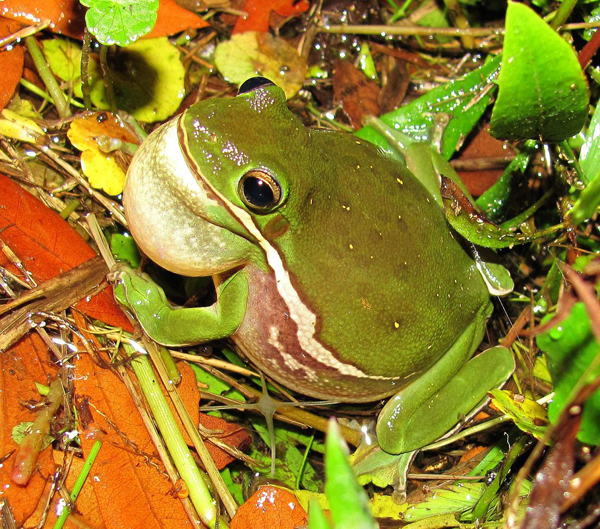
joe myers
Barking treefrogs sometimes hybridize with the Green treefrog (H. cinerea) producing an offspring with the characteristics of both species.
Perhaps I'll do a care sheet for these one day, but these do make good captives and are best kept by themselves since they are slower than others to react when food is dropped in. If kept along with green treefrogs for example, the greens will have already snapped up all the food dropped in for them while the Barkers are just starting to turn around to look at it.
Only males are necessary as "pets" since the females are best left in the wild for breeding, and releasing the captives late in the summer is best for them. It's always fun to go pick up a few fresh new ones the following year if you so desire, and with ALL herps it's best to check the laws of your state, since they may be protected in some areas. Anyway if you want a treefrog for a year-round pet, I would highly recommend the Cuban treefrog (Hyla septentrionalis), and save the Barkers for photographic subjects on warm springtime nights.
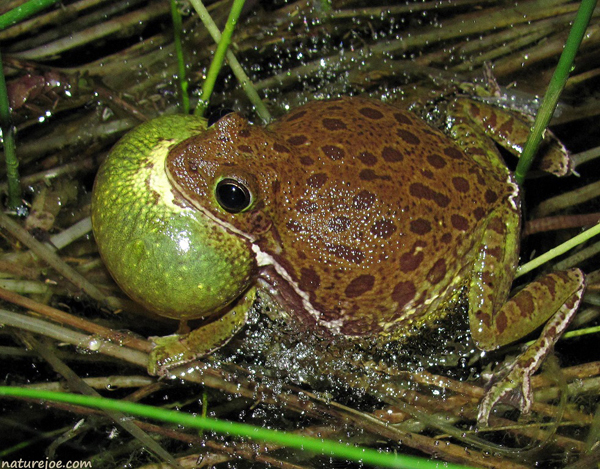
joe myers
Some species as they call explosively will send a spray of water off into the night air.
This is something you can do right at home if you want to attract these to your property if you live within their range. For a couple hundred dollars or less you can buy a large Rubbermaid-type or metal all-weather container with a drain in the bottom, and fill it about 2/3 full of water and add a few submerged potted plants (reed-like plants are better than "floating pads" like waterlilies), and allow this to grow naturally for at least a couple months.
During breeding season collect a pair, take them home and add them to a covered aquarium with several inches of water (preferably water collected on site at the breeding pond) along with some dead grass, push it down into the water so it's not floating high and dry, add the frogs, place the lid, and keep it outdoors overnight, and in the morning you should see many eggs. These will be attached to the grass, and carefully transfer this to the large container and let them do their thing. The tiny tadpoles will emerge in less than a week and in about a month they will be seen clinging to the sides beneath the water, and floating fish food makes a good food which they will soon discover, and in a couple months they will emerge and soon depart.
In two years they will return to breed there and you'll have them all around your house! Beware though as they are quite noisy, and if you like this sort of thing it will work just as well with spring peepers (Hyla crucifer ssp.) and other treefrogs also.
Like most frogs they will return to their larval home to breed, re-tracing their steps two years later. Again be sure to check your local laws because it may be illegal to even temporarily collect a pair even for the purpose of breeding them and the mere possession of the tadpoles in a container can be illegal as well in protected parts of their range. Also there's no reason to bury the container into the ground, since the frogs will climb their way into it when the time comes, but a bush growing up against the container will surely help. Also an above-ground container can be easily emptied and stored for the winter, long after the tadpoles have all developed and left.
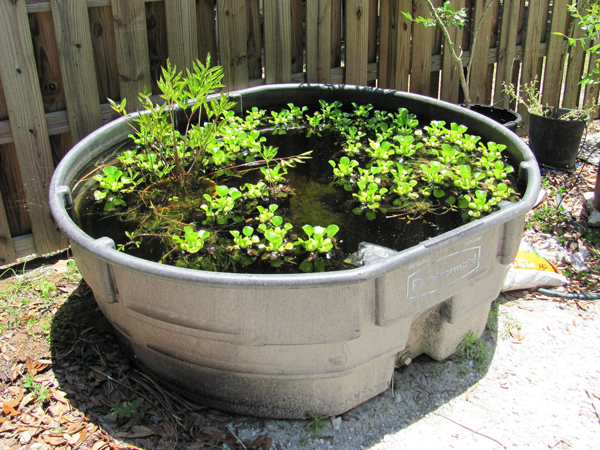
joe myers
This is a 300-gallon plastic container which I have set up naturally, and each year it hosts a number of Hylas (treefrogs) that were started here years ago as tadpoles.
"Nature" Joe (Myers) is a nature photographer and has many years of experience with the Eastern box turtle and field herping. He has been working with groups of people of all ages in an outdoor educational setting since 1986 and can be followed on Facebook https://www.facebook.com/n.joe.myers where his nature photography and time-lapse videos are displayed there publicly.


